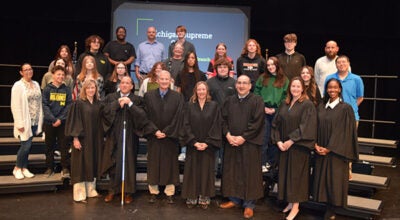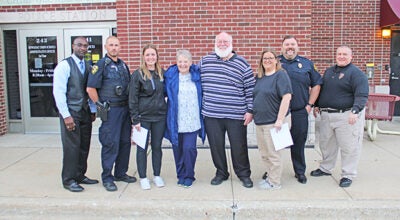Pokagons celebrate 30th annual Kee-Boon-Mein-Kaa Pow Wow
Published 10:20 am Tuesday, September 8, 2015

Native American dancers, wearing colorful traditional regalia, make their way inside the pow wow arena outside Dowagiac’s Rodgers Saturday during the grand entry ceremony of the 30th annual Kee-Boon–Mein- Kaa Pow Wow. The event, organized by Pokagon Band of Potawatomi, drew in hundreds of visitors from around the Great Lakes and beyond. (Leader photo/TED YOAKUM)
It started as a humble suggestion from a handful of leaders of a small, Michiana-based Potawatomi tribe.
Over the past three decades, just as the Pokagon Band has grown in prominence and prestige, so has its annual Labor Day celebration: the Kee-Boon-Mein-Kaa Pow Wow.
Despite a brief delay caused by the rainstorms that rolled into the area Saturday, hundreds packed the stands inside the Pokagon Band’s pow wow arena on Rodgers Lake, witnessing the procession of Native American dancers from around the Great Lakes area and beyond during the grand entry ceremony. It was the first of several large events during the weekend-long competition pow wow, which attracts more than 1,000 visitors from all over the U.S. and Canada.
As the ceremonies for the 30th rendition of the celebration rolled on Saturday and Sunday, it was time for many longtime organizers and volunteers to reflect on just how far it — and themselves — have come.
Kevin Daugherty, a longtime volunteer with the pow wow, is someone who has seen the event grow from being a traditional gathering of the tribe into the massive destination event it has become for many Native Americans.
“I always thought we put on a good pow wow, but it is great to see the word of mouth about it continue to spread throughout Native America,” Daugherty said.
Daugherty, whose father, Mike, was one of the leaders who helped spearhead the creation of the pow wow, has been volunteering with the event since its third year, he said. Back in those days, the pow wow was held at St. Patrick’s County Park in South Bend, which hosted the event until it moved onto tribal land in Dowagiac back in 2007.
One of the duties that Daugherty used to fulfill back then was building the drum arbor, the shelter that houses drummers and singers for the ceremonies, every year on the Indiana park grounds. Since they didn’t own the property, organizers would spend hours constructing the structure and then tear it down after the pow wow had ended.
“We built it enough times that we started to see where our old holes were at,” Daugherty said.
While the event enjoyed success during its years at St. Patrick’s, attendance and participation began to plateau in the 1990s, Daugherty said.
When the tribe brought the event to its pow wow area outside its headquarters in Dowagiac, it brought with it a number of big changes, most notably changing the format from a traditional pow wow to a judged, competitive one, one that would attract dancers from all over the Midwest and beyond.
“This is more of a public event,” Daugherty said. “We want to make this as big as it can be.”
Despite the growth, the pow wow is still mainly a time for members of the Pokagon Band and other local tribes to get together, see some old friends and family and share a little taste of their culture with their neighbors.
As for Daugherty, after nearly 30 years of helping out, he may take a well-deserved rest come this time next year.
“I might take a little break and just watch it next year,” Daugherty said.






